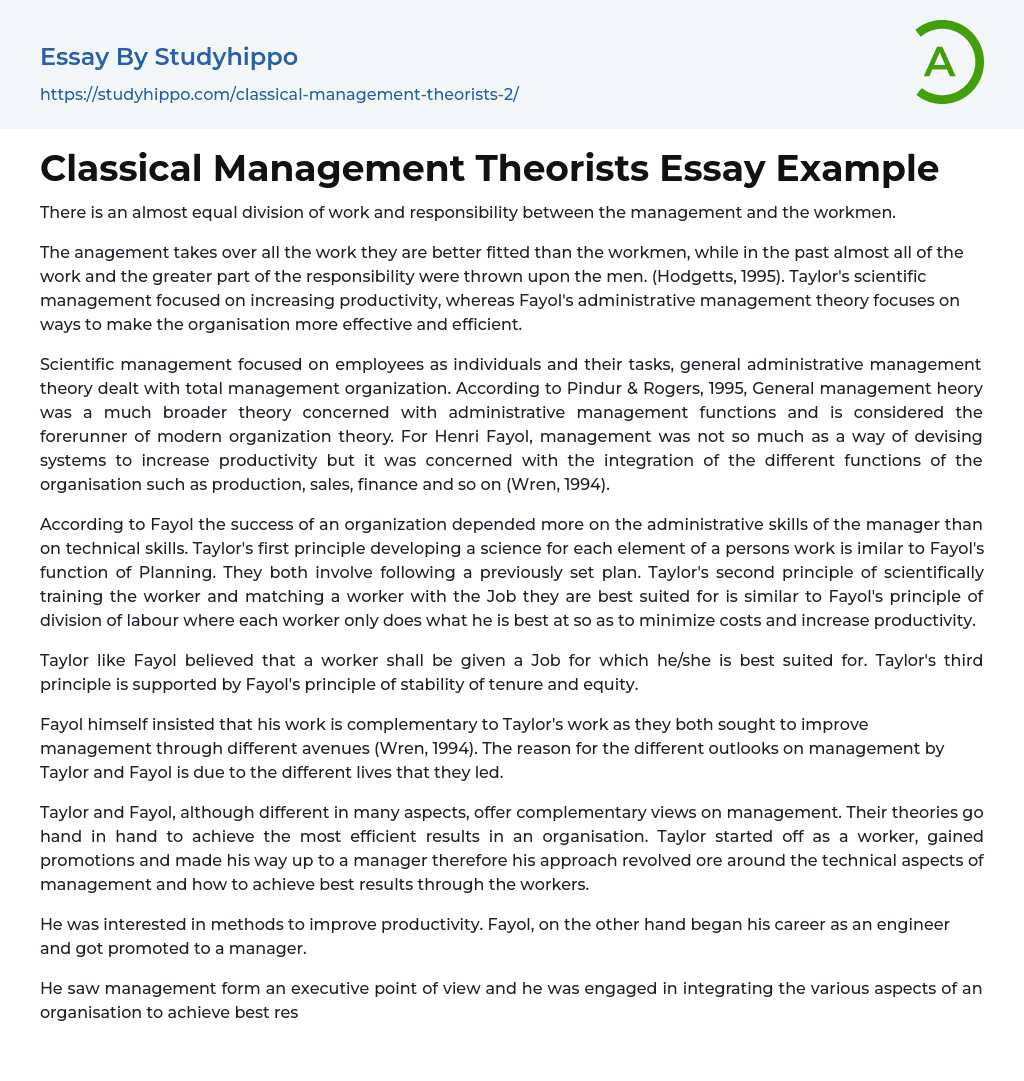There is an almost equal division of work and responsibility between the management and the workmen.
The anagement takes over all the work they are better fitted than the workmen, while in the past almost all of the work and the greater part of the responsibility were thrown upon the men. (Hodgetts, 1995). Taylor's scientific management focused on increasing productivity, whereas Fayol's administrative management theory focuses on ways to make the organisation more effective and efficient.
Scientific management focused on employees as individuals and their tasks, general administrative management theory dealt with total management organization. According to Pindur & Rogers, 1995, General management heory was a much broader theory concerned with administrative management functions and is considered the forerunner of modern organization theory. For Henri Fayol, ma
...nagement was not so much as a way of devising systems to increase productivity but it was concerned with the integration of the different functions of the organisation such as production, sales, finance and so on (Wren, 1994).
According to Fayol the success of an organization depended more on the administrative skills of the manager than on technical skills. Taylor's first principle developing a science for each element of a persons work is imilar to Fayol's function of Planning. They both involve following a previously set plan. Taylor's second principle of scientifically training the worker and matching a worker with the Job they are best suited for is similar to Fayol's principle of division of labour where each worker only does what he is best at so as to minimize costs and increase productivity.
Taylor like Fayol believed that a worker shall be given a Job for whic
he/she is best suited for. Taylor's third principle is supported by Fayol's principle of stability of tenure and equity.
Fayol himself insisted that his work is complementary to Taylor's work as they both sought to improve management through different avenues (Wren, 1994). The reason for the different outlooks on management by Taylor and Fayol is due to the different lives that they led.
Taylor and Fayol, although different in many aspects, offer complementary views on management. Their theories go hand in hand to achieve the most efficient results in an organisation. Taylor started off as a worker, gained promotions and made his way up to a manager therefore his approach revolved ore around the technical aspects of management and how to achieve best results through the workers.
He was interested in methods to improve productivity. Fayol, on the other hand began his career as an engineer and got promoted to a manager.
He saw management form an executive point of view and he was engaged in integrating the various aspects of an organisation to achieve best results. They had similar views and their objective was the same.
It was only their approach to achieve these results that differed. If Fayol's and Taylor's priciples of management are both implemented in an rganisation, it is bound to achieve results in terms of efficiency and productivity and profits in the long run.
Fayol and Taylor had similar views. A primary difference between the two is that Taylor viewed the process of management form the bottom, that is, form the workers point of view, whereas Fayol viewed the process from the top, that is, from the manager's point of
view.
Taylor observed the workers actions then studies the effects of their actions on productivity, devised new methods for making them more efficient, and applied what he learns at lower levels to the eiararcy.
Fayol synthesised various views or principles of organisation and management and Taylor on work methods, measurement and simplification to secure efficiencies but both methods go together to achieve best results. References Hodgetts, G. , (1995) Frederick Taylor: Alive and well and ready for the 21st century, Academy of Management Journal, p. 218-223.
Pindur, W. & Rogers. S 1995 The History of Management: a global perspective, Journal of Management History vol 1 Noll . pp59-77 Wren, D.
, (1994) The Evolution of Management Thought, John Wiley and Son, New York.
- Animals essays
- Charles Darwin essays
- Agriculture essays
- Archaeology essays
- Moon essays
- Space Exploration essays
- Sun essays
- Universe essays
- Birds essays
- Horse essays
- Bear essays
- Butterfly essays
- Cat essays
- Dolphin essays
- Monkey essays
- Tiger essays
- Whale essays
- Lion essays
- Elephant essays
- Mythology essays
- Time Travel essays
- Discovery essays
- Thomas Edison essays
- Linguistics essays
- Journal essays
- Chemistry essays
- Biology essays
- Physics essays
- Seismology essays
- Reaction Rate essays
- Roman Numerals essays
- Scientific Method essays
- Mineralogy essays
- Plate Tectonics essays
- Logic essays
- Genetics essays
- Albert einstein essays
- Stars essays
- Venus essays
- Mars essays
- Evolution essays
- Human Evolution essays
- Noam Chomsky essays
- Methodology essays
- Eli Whitney essays
- Fish essays
- Dinosaur essays
- Isaac Newton essays
- Progress essays
- Scientist essays




